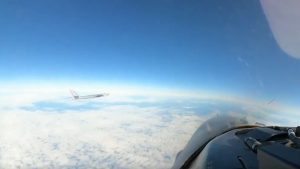Reviews
User Score
Rate This
Descriptions:
The Mil Mi-12 (V-12) was a 120-seat heavy transport helicopter powered by four Soloviev D-25VF turbo shaft engines. Footage of the first flight was released in 1968. This giant helicopter had fixed wings and was lifted by two Mi-6 rotors mounted at the ends of outrigger wings. Two [or three??] prototypes of MI 12 were built, but the helicopter never entered production.
Although it was constructed only two copies of Mil Mi-12 (V-12) experimental helicopter, the famous giant machine is the biggest helicopter in the world. Rotor, transmission and engine were taken from the MI-6, but are duplicated and located at the ends of the still backed truss brace consoles wing. The use of two rotating in opposite directions rotor ruled out the need for a tail propeller, and the plumage was traditional – with two additional washers at the end inhibitor. Four turbovalnyh engine Soloviev D-25VF had a total capacity of the shaft 19388 KW (26000 HP), which enabled a helicopter-12, first took off July 10, 1968., Set in February 1969. a series of records that will be presented for approval were first received in the West reported on the existence of the giant helicopter. He received the NATO code of"Homer" ( "Homer"). Later, on 6 August 1969., B-12 raised the payload 40204.5 kg (88,636 pounds) to an altitude of 2255 meters (7398 feet), setting a record which has so far not exceeded. The first test copy was destroyed during landing (with no deaths) in 1969. The second Mi-12 participated in the demonstration flights.
The Mil Mi-12, known as V-12 in the Soviet Union, and by the NATO reporting name Homer, is so far the only helicopter produced by the Mil bureau to depart from the single main rotor plus tail rotor formula. The tandem rotor (or twin-rotor) configuration is used mainly with large helicopters. Because of the opposite rotation of the rotors, the torque of each single rotor is neutralized. The construction of the control system is much more complicated compared to a helicopter with a tail rotor. The arrangement of two rotors side by side was never very popular. This design was used for the largest helicopter ever built – the Mil Mi-12.
The giant V-12 was a four-engine troop-carrier helicopter of twin-screw transverse layout. Power plants from Mi-6 were fastened to the ends of the truss consoles. The diameter of the finished rotors proved to be insufficient for this helicopter that it required boosting initial power plants. Two main rotors contra-rotating, slightly mesh into one another, turning A122 rpm, are mounted each at the end of a wing. The left rotor turns in the direction clockwise, the right rotor in the opposite direction to clockwise, seen from below. The metal blade entirely, each weighing 840 kg for 17 m in length are composed of metal spar on a tight tubular diameter, but whose thick walls are decreasing. The hubs are a classic cyclical plateau consists of two welded half-shells. The two rotors are linked by two shafts rigid, leading large diameter, a central gear box with a take-off (drive hydraulic pumps). This transmission is calculated so as to transmit the power necessary with two turbines arrested on the same side.
Four Soloviev D-25VF turboshaft engines developing 4 850 kW each are mounted in pairs. Each pair is coupled to cause a rotor, but is also interconnected with each other to ensure relief lift of the aircraft. The lower cowl under each pair may fall to 1.80 m with a crank, to form a working platform where three men maintain engines and the rotor head. The rollovers for later fell back down to the same purpose. For the V-12 the OKB P.A.Solovyev created the special modification of the production engine D-25f with a power of 6500 hp. In the center section the intermediate gearbox, which ensured the fracture of power shaft, was established. Power shaft synchronized the rotation of had three-meter overlap rotors and delivered power from one reducer to another with the roll control and in the case of failure of one or even two engines from one side. Fuel was placed in the wing and external external fuel tanks.
The wings with a contraction of less than one had a small dihedral angle for an improvement in the piloting helicopter characteristics. The high rise wing of inverted trapezoidal shape in plan view, the string is the smallest side emplanture at corner and many high profile guy, is metal construction. Flap-edges equip the prototype but would no longer appear on the aircraft. The fuselage, construction classic semi-monocoque, all-metal, has in the back of a rack and two doors opening in shell laterally. The ramp is equipped with two large bumper side by side to adjust the height from the ground.
The fuselage of the V-12 was executed in the form semi-monocoque and resembled inside, according to descriptive expression of one of the foreign specialists, the gigantic Gothic cathedral. Two-story flight deck occupied its forward section. The cockpit, very classic, is located halfway up the front of the fuselage. It is occupied by a pilot on the left, a co-pilot side by side, right, a flight engineer behind the driver and an electrician behind the co-pilot. On the upper deck, above the cockpit are the positions of the browser and the radio operator. The crew would only fan blades rubber for air conditioning. A large cargo freighter, without any obstruction following posts before. The ceiling has rails on which the wings, from one end to another of the fuselage, a crane with 10 tons capacity. Fifty people can be carried on canvas folding seats against the side walls. Access to the main cabin is done by two side doors left and right, the crew with sliding doors front right and left. The cargo and vehicles entering the ventral rear hatch. In the aft fuselage section the power ladder and the lateral folds, which during deployment formed aperture for the entrance of self-propelled technology and loading of different loads with the aid of the powerful electric hoists and the telphers, were found. Center fuselage occupied large cargo hold by the size of 28,15 X of 4,4 X of 4,4 meters.







